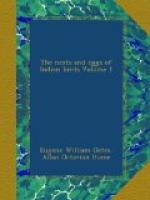The breeding-season lasts from early in December to quite the end of March; but this varies a little according to season and locality, though the majority of birds always, I think, lay in January.
The nest is generally placed in single trees of no great size, standing in fields or open jungle. The thorny Acacias are often selected, but I have seen them on Sisoo and other trees.
The nest, placed in a stout fork as a rule, is a large, strong, compact, stick structure, very like a Rook’s nest at home, and like these is used year after year, whether by the same birds or others of the same species I cannot say. Of course they never breed in company: I never found two of their nests within 100 yards of each other, and, as a rule, they will not be found within a quarter of a mile of each other.
Five is, I think, the regular complement of eggs; very often I have only found four fully incubated eggs, and on two or three occasions six have, I know, been taken in one nest, though I never myself met with so many.
I find the following old note of the first nest of this species that I ever took:—
“At Hansie, in Skinner’s Beerh, December 19, 1867, we found our first Raven’s nest. It was in a solitary Keekur tree, which originally of no great size had had all but two upright branches lopped away. Between these two branches was a large compact stick nest fully 10 inches deep and 18 inches in diameter, and not more than 20 feet from the ground. It contained five slightly incubated eggs, which the old birds evinced the greatest objection to part with, not only flying at the head of the man who removed them, but some little time after they had been removed similarly attacking the man who ascended the tree to look at the nest. After the eggs were gone, they sat themselves on a small branch above the nest side by side, croaking most ominously, and shaking their heads at each other in the most amusing manner, every now and then alternately descending to the nest and scrutinizing every portion of the cavity with their heads on one side as if to make sure that the eggs were really gone.”
Mr. W. Theobald makes the following note of this bird’s nidification in the neighbourhood of Pind Dadan Khan and Katas in the Salt Range:—
“Lay in January and February; eggs, four only; shape, ovato-pyriform; size, 1.7 by 1.3; colour, dirty sap green, blotched with blackish brown; also pale green spotted with greenish brown and neutral; nest of sticks difficult to get at, placed in well-selected trees or holes in cliffs.”
I have not verified the fact of their breeding in holes in cliffs, but it is very possible that they do. All I found near Pind Dadan Khan and in the Salt Range were doubtless in trees, but I explored a very limited portion of these hills.
Colonel C.H.T. Marshall, writing from Bhawulpoor on the 17th February, says: “I succeeded yesterday in getting four eggs of the Punjab Raven. The eggs were hard-set and very difficult to clean.”




